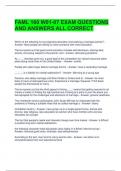FAML 160 W01-07 EXAM QUESTIONS
AND ANSWERS ALL CORRECT
Which of the following is true regarding education and seeking a marriage partner? -
Answer- Most people are willing to marry someone with more education.
The text points out that good communication includes self-disclosure, sharing daily
events, conveying respect to the partner, and - Answer- discussing problems
As ____ theorists point out, a good deal of the competition for valued resources takes
place along racial lines in the United States. - Answer- conflict
People who date longer before marriage tend to - Answer- have a rewarding marriage
______ is a liability for marital satisfaction? - Answer- Marrying at a young age
Persons, who delay marriage until their thirties or forties tend to - Answer- be more
likely to have a heterogamous union, Experience a marriage "squeeze," Find fewer
people like themselves to marry.
The text points out that the third aspect of timing ____ means that getting married is not
merely a matter of finding the right partner but of being at a point in your life where you
feel equipped for the challenges and adventure of marriage - Answer- general readiness
The nineteenth-century philosopher John Stuart Mill was so impressed with the
problems of finding a suitable mate that he called marriage a - Answer- lottery
Cohabitors tend to - Answer- have grown up in a single-parent home, homes with
divorce, less religious, less educated, be women who have mothers who are less
educated, be younger
The fact that people's needs and interests change over time makes - Answer- it difficult
to predict long-term marital satisfaction
the following character traits did people value highly in a British Internet survey -
Answer- General good looks, kindness, face attractiveness
According to the text, men tend to marry women who - Answer- are either at or
somewhat below their own educational level
, timing has three parts - Answer- how long you've known each other, age, general
readiness for marriage
Propinquity - Answer- proximity or kinship
three important ways to build intimacy - Answer- self disclosure, intimacy is exchanged,
interdepended commitments
Waring and Chelune (1983) says there are four ways to build intimacy - Answer-
Sharing emotions
Sharing needs personal, in the relationship, in general
Sharing thoughts, beliefs, attitudes, fantasies
Sharing their self awareness
Self disclosure varies with - Answer- age, sex, race, gender role orientation
Storge is - Answer- Parents and child, least discriminating
Philia is - Answer- Friends, warm, affection, commitment, sharing, similar perspectives
eros is - Answer- Men and Women, sexual but also longing for a particular person
agape is - Answer- Altruistic, independent of whether we like them or not, will
The process of falling in love is - Answer- rapport, self disclosure, mutual dependency,
fulfillment of intimacy needs
Using a small sample of 73 male and 173 female students who had been passionately
in love, dated, and then broke up, three researchers (Choo, Levine, and Hatfield) found
a number of gender differences. Which of the following was a gender difference found
during the research study? - Answer- As a coping style, the men were more likely than
the women to bury themselves in work or sports.
According to Susan Sprecher's research, these factors were found to be associated with
only the sense of being underbenefited in a relationship. - Answer- Higher likelihood of
breaking up, lower satisfaction, lesser commitment
The number of males per 100 females is referred to as the - Answer- sex ratio
Which of the following resources was used to assess the extent to which individuals
found their partners' contribution as rewarding in relationships? - Answer- sex, material
goods, information, ect.
In 2014, the Census Bureau reported more than ____ Americans aged 18 and older
who were unmarried. - Answer- 105 million




